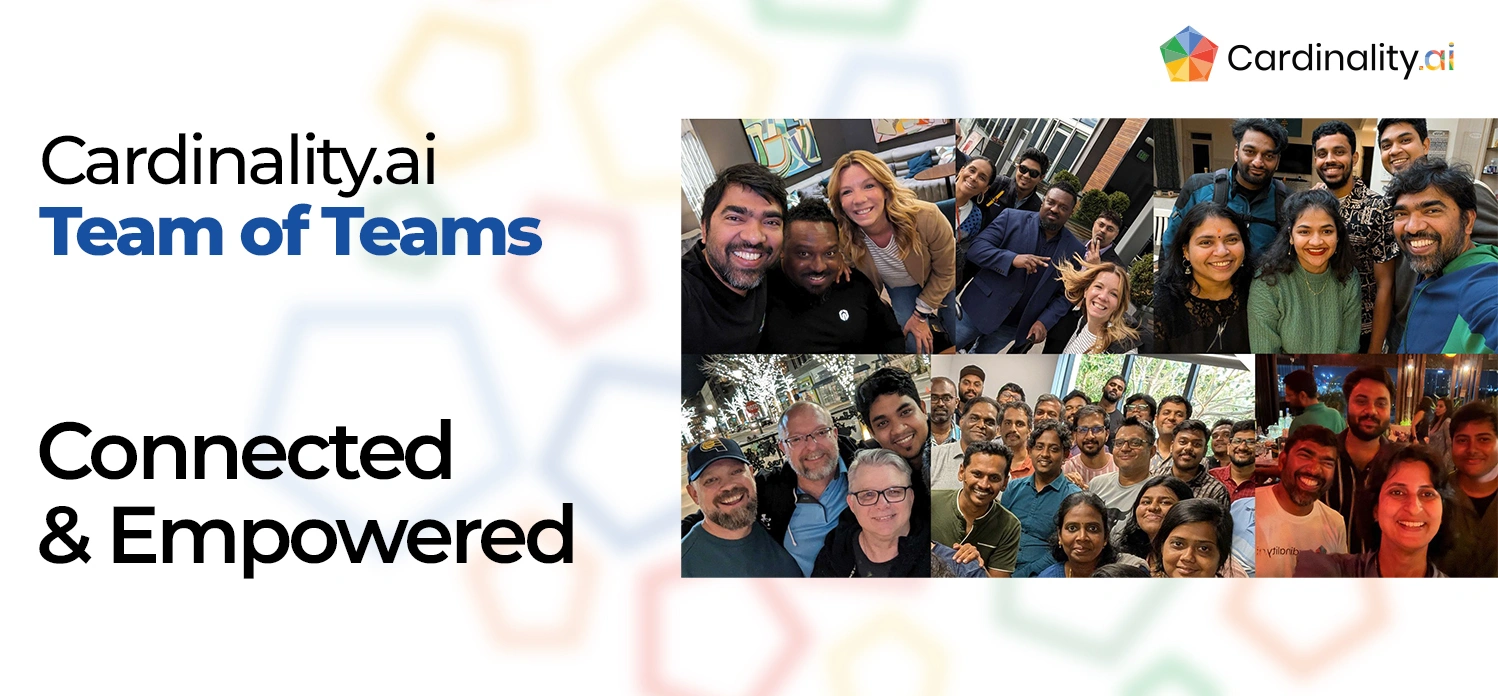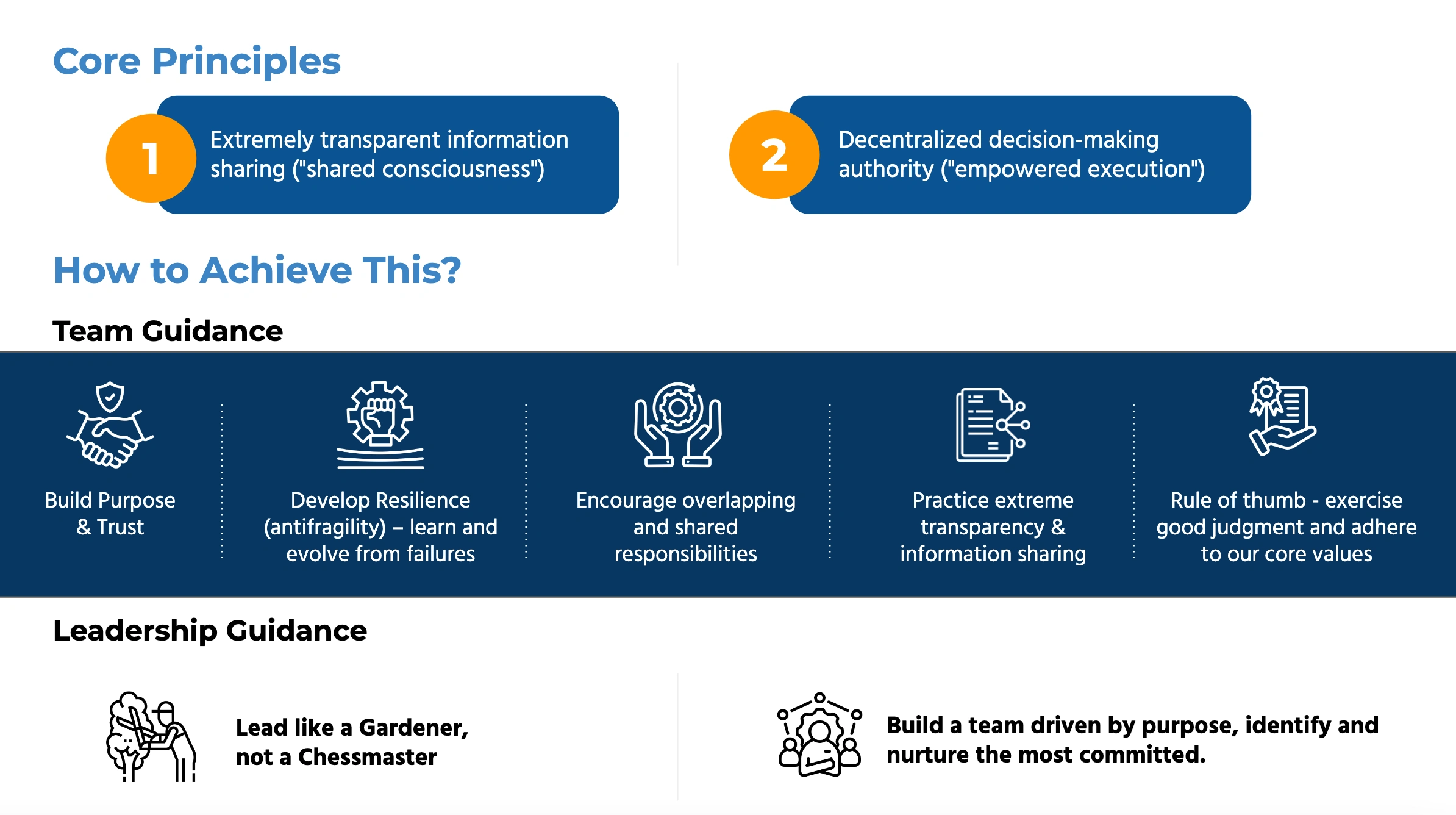
Rethinking How We Scale: Lessons from Team of Teams

By Ritu Raj
Reading Team of Teams by General Stanley McChrystal left me thinking about how organizations need to operate in today’s world. The book describes how the U.S. military had to transform itself when faced with a fast-moving, unpredictable enemy. Traditional hierarchies designed for efficiency and control simply couldn’t keep up with the complexity of the environment. The response wasn’t more layers of command or stricter processes, but something different: shared consciousness (Extremely transparent information sharing) and empowered execution (Decentralized decision-making authority).
That lesson applies far beyond the military. Every growing organization faces the same challenge: how do you scale in a way that keeps you adaptable, connected, and resilient?
To achieve this in practice, teams need deliberate guidance. Purpose and trust form the foundation, but resilience is equally important. Failure should not be the end state; rather, it should propel the team forward. Just as a failed project in one context can strengthen the mission overall, organizations must ensure that setbacks whether in programs, systems, or even security incidents do not undermine their long-term viability.
Complexity vs. Complication
One of the book’s core distinctions is between the complicated and the complex. A plane is complicated as it has thousands of parts, but it’s ultimately predictable. Human systems, by contrast, are complex. They’re dynamic, interdependent, and full of surprises.
Interestingly, airplanes have become safer over time precisely because organizations embraced transparency, cross-disciplinary learning, and continuous feedback loops. That’s a reminder that complexity doesn’t have to equal chaos. But it does demand a different kind of organizational design which is more flexible, more interconnected, and more open.
Doing the Right Thing
In traditional systems, success often means “doing things right” i.e. following the process, checking the boxes, etc. But in complex environments, that’s not always enough. Sometimes the bigger question is whether we’re doing the right thing in the first place.
This requires more than training people on steps and procedures. It requires giving them the context and judgment to recognize when to adapt. That shift from being compliant with processes to critical thinking becomes a competitive advantage
From Hierarchies to Meshes
Most organizations are often pictured as pyramids: layers of authority, information flowing up and down. Team of Teams offers a different image: the mesh. In a mesh, every node is important, but so are the connections between nodes. A team can only be strong if it’s plugged into the larger network, sharing information and reinforcing others.
This shift doesn’t mean eliminating hierarchy altogether. It means supplementing it with horizontal connectivity so teams aren’t just accountable upward, but also connected horizontally across different project teams, business functions, etc. The health of the mesh depends on those links.
Transparency as a Default
A big theme in the book is information sharing. In traditional organizations, leaders decide who “needs to know.” But in complex systems, it’s impossible to predict where the right insight and information will matter. By defaulting to transparency, we give people the chance to connect dots that might otherwise be missed.
Organizations can operationalize this with simple habits: project home pages where everyone can see progress, weekly leadership calls to align priorities, daily operational check-ins to surface risks early, and open Slack channels to keep conversations flowing across silos. These touchpoints make transparency a routine, not an exception.
Yes, there’s always a risk of misinterpretation. But the bigger risk is slowing the flow of knowledge and slowing down decisions.
A New Role for Leadership
All of this requires leaders to reimagine their role. McChrystal contrasts two models: the chessmaster, who controls every move, and the gardener, who creates the conditions for growth.
In the gardener model, leaders focus less on directing actions and more on cultivating trust, clarity, and connections. Their role is to make sure the soil is fertile and necessary resources are available, so teams can make decisions with confidence.
This connects to what the book calls the “Visible Man” approach: eyes on, hands off. Leaders stay informed, but they don’t micromanage. Instead, they provide enough context and visibility for people to use their judgment.
Building for Resilience
Finally, the book distinguishes between training and education. Training equips people for what’s known; education prepares them for what’s unknown. In stable environments, training is enough. In complex environments, resilience comes from education because it builds adaptability when the usual script no longer applies.
Scaling Differently
When organizations grow, the instinct is often to add more rules, more approvals, more control. Team of Teams argues for another path. To thrive in complexity, we need to:
- Build stronger connections across teams, not just up and down.
- Default to transparency so people see the whole system.
- Empower people with context and trust them to act.
- Redefine leadership as cultivating conditions, not controlling moves.
Scaling isn’t simply about adding more people. It’s about how those people connect, share, and act together. In a growing organization built for solving complex problems, building shared consciousness and empowering decision-making closer to where the actual work is being conducted.
Quick Cheat Sheet: Team of Teams





